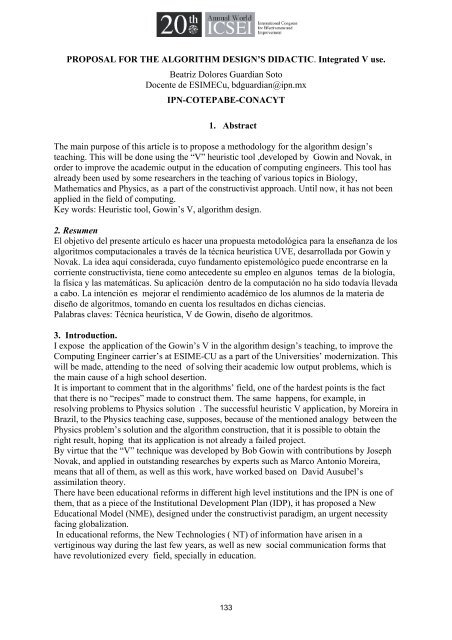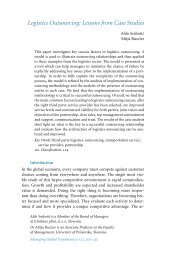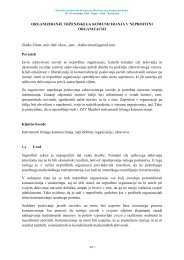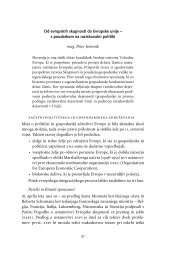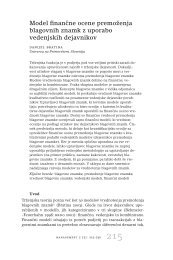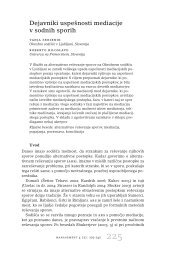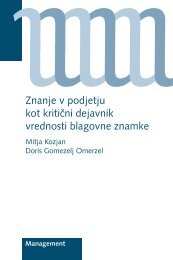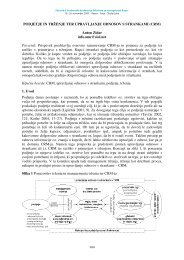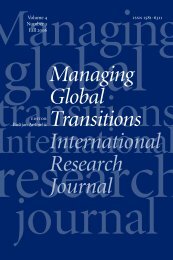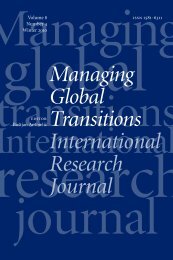PROPOSAL FOR THE ALGORITHM DESIGN'S DIDACTIC ...
PROPOSAL FOR THE ALGORITHM DESIGN'S DIDACTIC ...
PROPOSAL FOR THE ALGORITHM DESIGN'S DIDACTIC ...
Create successful ePaper yourself
Turn your PDF publications into a flip-book with our unique Google optimized e-Paper software.
<strong>PROPOSAL</strong> <strong>FOR</strong> <strong>THE</strong> <strong>ALGORITHM</strong> DESIGN’S <strong>DIDACTIC</strong>. Integrated V use.<br />
Beatriz Dolores Guardian Soto<br />
Docente de ESIMECu, bdguardian@ipn.mx<br />
IPN-COTEPABE-CONACYT<br />
1. Abstract<br />
The main purpose of this article is to propose a methodology for the algorithm design’s<br />
teaching. This will be done using the “V” heuristic tool ,developed by Gowin and Novak, in<br />
order to improve the academic output in the education of computing engineers. This tool has<br />
already been used by some researchers in the teaching of various topics in Biology,<br />
Mathematics and Physics, as a part of the constructivist approach. Until now, it has not been<br />
applied in the field of computing.<br />
Key words: Heuristic tool, Gowin’s V, algorithm design.<br />
2. Resumen<br />
El objetivo del presente artículo es hacer una propuesta metodológica para la enseñanza de los<br />
algoritmos computacionales a través de la técnica heurística UVE, desarrollada por Gowin y<br />
Novak. La idea aquí considerada, cuyo fundamento epistemológico puede encontrarse en la<br />
corriente constructivista, tiene como antecedente su empleo en algunos temas de la biología,<br />
la física y las matemáticas. Su aplicación dentro de la computación no ha sido todavía llevada<br />
a cabo. La intención es mejorar el rendimiento académico de los alumnos de la materia de<br />
diseño de algoritmos, tomando en cuenta los resultados en dichas ciencias.<br />
Palabras claves: Técnica heurística, V de Gowin, diseño de algoritmos.<br />
3. Introduction.<br />
I expose the application of the Gowin’s V in the algorithm design’s teaching, to improve the<br />
Computing Engineer carrier’s at ESIME-CU as a part of the Universities’ modernization. This<br />
will be made, attending to the need of solving their academic low output problems, which is<br />
the main cause of a high school desertion.<br />
It is important to comment that in the algorithms’ field, one of the hardest points is the fact<br />
that there is no “recipes” made to construct them. The same happens, for example, in<br />
resolving problems to Physics solution . The successful heuristic V application, by Moreira in<br />
Brazil, to the Physics teaching case, supposes, because of the mentioned analogy between the<br />
Physics problem’s solution and the algorithm construction, that it is possible to obtain the<br />
right result, hoping that its application is not already a failed project.<br />
By virtue that the “V” technique was developed by Bob Gowin with contributions by Joseph<br />
Novak, and applied in outstanding researches by experts such as Marco Antonio Moreira,<br />
means that all of them, as well as this work, have worked based on David Ausubel’s<br />
assimilation theory.<br />
There have been educational reforms in different high level institutions and the IPN is one of<br />
them, that as a piece of the Institutional Development Plan (IDP), it has proposed a New<br />
Educational Model (NME), designed under the constructivist paradigm, an urgent necessity<br />
facing globalization.<br />
In educational reforms, the New Technologies ( NT) of information have arisen in a<br />
vertiginous way during the last few years, as well as new social communication forms that<br />
have revolutionized every field, specially in education.<br />
133
4. Exposition<br />
AT the end of the millennium, Epistemology has opened big debates and developed new<br />
theories. This has contributed to the rise of assimilation theory, taking the essence of<br />
constructivism, whose base is starting from two movements strongly developed inside<br />
modernity. These are the “cogniscitivism”, represented by Piaget, and the Vygotsky’s<br />
conductism, a valid epistemological trend, in which it is evident that the comprehension of the<br />
world doesn’t come from its discovering but from the principles applied to manifest it.<br />
The cognitive aspects of Jean Piaget’s theory had influence on the Ausubel focus,<br />
fundamentally with the significant learning by reception theory, in which it is said that the<br />
learning occurs when the material is presented in its final form and related to the students<br />
previous knowledge.<br />
The assimilation theory fosters the active participation of the student and the teacher as the<br />
true bearings; how to teach, teaching supposes listening, talking, not narrating, “because is<br />
listening as we learn to speak to the others” (Freire, 1997).<br />
Therefore, the result of the interaction between a new material and a cognitive existent<br />
structure is a new and old significant assimilation. In the assimilation process, the relationship<br />
between the anchor- ideas and assimilated ones remains at the cognitive structure.<br />
Ausubel makes a reference to the learning statements in the classroom which can’t be applied<br />
directly, or immediatelyto learning in the classroom could behighlighted:<br />
I) Significant –learning repetition.<br />
II) Discovering – repetition.<br />
In short, it is better that the student has a significant not mechanical learning, a learning by<br />
discovering and not by reception in the classroom. Whit this learning, the teacher has and<br />
important role since a non traditional teacher is required who is able to be evolutionary,<br />
investigative, innovative, interactive respectful and some other characteristics (Freire,2004).<br />
It has already been mentioned that in the classroom, one of the relevant activities in which the<br />
learning referred by Ausubel takes part, is the problems resolution, also a fundamental activity<br />
in this work, for being the algorithm, its final design. Nevertheless, the Problems Resolution<br />
(PR) has neither only one way, nor a solution method. The constant search for techniques to<br />
give an original and creative PR has generated solution research methods and “heuristic<br />
strategies to facilitate the Problems Resolution” (Moreira, 1999).<br />
The final objective in teaching is that students learn how to solve problems, acquiring the<br />
habit of wonder and solve problems as a way to learn (Pozo, 1994).<br />
The Problems Resolution (PR) is a process that must penetrate all curricular design ,as well<br />
as provide the context in which the concepts and the attitudes can be learned.<br />
Creativity, for Ausubel, is an essential element in the PR. Likewise, it involves original<br />
transformations of the ideas and the generation of new integrating principles. However, it<br />
differs in each student, because of their different capacities in the Problems Resolution; that is,<br />
the ability to solve them depends on thepeoples’ creativity and talent.<br />
The significance of the PR in the programming courses is so big that several researchers have<br />
designed different strategies and resources to support students in Computational Problems<br />
Resolution (CPR). The algorithm design is characterized by its application, its creative and<br />
generating processes, since a particular problem is going to have a solution that will defer<br />
depending on the subject’s creative and ingenuous capacity.<br />
The CPR compromise students to do activities with a purpose, originating from problematic<br />
situations that have been presented to them. These situations require a creative thought that<br />
permits conjecture, discovery, invention and communication of ideas, as well as proving<br />
these ideas among the critical reflection and the argumentation.<br />
Ausubel, Novak y Gowin have looked for applicable didactic techniques in the construction<br />
of knowledge as conceptual maps and the heuristic V. The first ones with the concept<br />
134
etention support, and the latter as PR help, putting together the conceptual and the<br />
proceeding parts.<br />
A fundamental role in the educational CPR in the algorithm’s design, among the<br />
methodology, is the introducing of the V heuristic tool which is mainly based on two theories<br />
that ofNovak education and that of Gowin heuristic. Therefore, we must briefly comment<br />
onthese models in order to understand the proposed model cause.<br />
5. The algorithms and their teaching.<br />
¿How can we understand the Algorithms Teaching (AT) and the Algorithms Learning (AL),<br />
without considering its evolution in time and space, its place among the teaching and learning<br />
technological revolutions?<br />
As soon as computing history is divided into generations for its study, this division is based<br />
on technological progresses that permit important advances in the software and hardware<br />
fulfillment, in which they take part to delimit the beginning and the end of each phase and its<br />
progress.<br />
Within the so called “algorithms phases” their evolution is classified. They’re considered as<br />
the whole of principles that rules a paradigm and defines the algorithms’ semantic and<br />
axiomatic characteristics as much as its relation with the hardware evolution.<br />
First phase: Structured algorithms.<br />
It arise with the introducing of control and algorithms data base structures and it’s born under<br />
the structured programming paradigm(Dijkstra, Horowitz, 1976-1978) (Boom, Jacopini 1996)<br />
(Alcalde, García 1992:221-224). In the same way,<br />
Teaching and learning techniques arise as ascendant programming, descendant, modular,<br />
of recursion, turn behind, as some others.<br />
Second phase: TDA algorithms, CAO, cryptography.<br />
It arises with the introduction of abstract data(Hoare, 1972: 31-42; Lizkov, Zilles, 1974: 50-<br />
59), cryptography (Parnas, 1972: 330-336), and the algorithmic complexity application (Baase,<br />
2002; Brassard, 1998; Harel, 2004) on the algorithms analysis and design. The same<br />
techniques are used as in the fourth phase, but now the algorithm efficiency is measured.<br />
Concerning the algorithmic complexity, the computing algorithms syntactic in addition to the<br />
linguistic and axiomatic part, have been developed by many researchers:<br />
Tarjan (1985), Barry (2003) and Sedgewick (1995).<br />
Third phase: Intelligent algorithms.<br />
Begins with the artificial intelligence and the neuronal nets. Some projects, guided to<br />
improve the algorithms learning arise based on tutorials simulators and logical programming.<br />
There are also, the learning by discovery(Cernuda, 2005), and the Strategy application in<br />
Education(Moroni, Señas, 2005).<br />
Fourth phase: Structured Algorithms.<br />
The computation specialists try to develop efficient algorithms that carry out the emergent<br />
necessities as result of the third industrial revolution, in the eighties; involving universities in<br />
order to generate computing professionals that support the technological expansion.<br />
Fifth phase: Intelligent algorithms.<br />
The emergence of this last phase has been a key to develop the educational software and<br />
virtual innovations in the same field. This has permitted the globalization of education and<br />
sharing of advances in pedagogic theories and technological ideas.<br />
If we reflect on the phases mentioned before, we can visualize that the time have elapsed fast<br />
for the enormous advances given since the physical construction of the first computer, at the<br />
beginning of the forties at the twentieth century. Consequently, we need to train high<br />
competitive professionals, ready to fight for the best market’s jobs in this globalization era.<br />
Student, sure of their training, learning independence and mastery in any kind of problem<br />
135
presented, must be an excellent professional in order to be a constructive part of the<br />
modernization project.<br />
It is relevant to point that to make good use of some technological advances’ qualities it is<br />
fundamental to have access to good algorithms. They are the essence and the computers’<br />
reason of being, because they function starting from these algorithms. Therefore, it is<br />
fundamental the way we teach this aspect to the new computing engineers’ generations. It’s<br />
the teachers role to introduce learning techniques as the heuristic V in order to help students<br />
in this knowledge construction and develop their CRP skills.<br />
By virtue of that the V technique was developed by Bob Gowin with Joseph Novak<br />
contributions and had been applied in relevant researches by experts as Marco Antonio<br />
Moreira. It is important to know that all of them have work based on the David Ausubel<br />
assimilation theory postulates as well as the Joseph Novak education concepts. This research<br />
has its hypothetical bases in the already mentioned theories. However the genesis of this<br />
theoretical environment has arisen from the conductivist and cognoscitivist theories,<br />
described in the following paragraphs.<br />
6. Methodological propose<br />
The algorithm teaching results hard work, since is not only a concepts transmission to be<br />
learned by students. This requires a complex proceeding method in which various factors are<br />
to be considered by the docent for its didactic strategy intervene, taking in to account the<br />
inherent elements related with the student apprenticeship.<br />
Some primordial aspects in a strategy design for the algorithms teaching, are the conceptual<br />
part and the proceed chosen, besides the characteristics that define its classification and<br />
evolution. The algorithms teaching consists of identifying what the student already knows<br />
related to the algorithmic requirements. Starting from there a new knowledge will be provided,<br />
motivating and introducing students to these new knowledges in a non arbitrary way, using<br />
for this:<br />
a) The previous knowledge structures as the anchor.<br />
b) Techniques that help the optimal and efficient algorithms’ construction work.<br />
It is primordial to bear in mind, starting from the problem’s presentation to the students, the<br />
process that follows. The solution’s abstraction and simulation if it is, among and algorithm,<br />
is complex and abstract. Its solution is an heuristic process that needs the right solution<br />
model representation as it is represented in the following conceptual map.<br />
With the introduction of this model, the subjects will be involved in the apprenticeship of the<br />
algorithm design to the Problems resolution, possibly in Computational Mathematics and<br />
Programming (as Programming fundaments, Oriented Programming for objects, Algorithms<br />
analysis, Algorithms Design Problems Computational Mathematics using (Cormen, 2001)<br />
and Discrete Mathematics ). This investigation is initially dedicated to the first semester<br />
students and the fifth semester guardianship of the Computation Programming Engineer at<br />
ESIME Cu, having as the objective the fostering of the centered apprenticeship on the student<br />
among the techniques used such as the Integral Gowin's “V”.<br />
7. Proposed Model<br />
It’s tacitly accepted that the apprenticeship process of any high level subject<br />
( particularly in programming subjects) is susceptible to improve itself by means of teaching<br />
techniques. Nevertheless, it is already known that Didactic includes tools but is more ample<br />
than that; to begin, we have those techniques that are maybe appropriate but wrongly<br />
implanted by the teacher or wrongly applied by the student.<br />
136
Taking the students inherent elements related to its apprenticeship, the algorithms teaching<br />
can be described as the transmission of experience, concepts and the methodologies to make<br />
students interested in a significant learning that is not lineal or arbitrary, starting from what<br />
the student already knows.<br />
In that case, considering the Ausubel, Novak and Gowin models, algorithms teaching is to<br />
identify and know what the student already knows with respect to the algorithmic<br />
requirements. In this way new knowledge will be afforded to students, motivating and will<br />
introduce them into these new concepts considering their context in which they learn<br />
interacting with the proceed and concept elements.<br />
On the other hand, We have to consider the inherent factors to the teacher and students<br />
concerning their availability and motivation in teaching as much as in learning. In this<br />
proposed model the Ausubel, Gowin y Novak priciples are taking into account, with Moreira<br />
observations, constructing this so called “V” under different focuses that try to innovate it:<br />
a) Conceptual focus<br />
It analyzes concepts, variables, laws, Hypothesis and theories that intervene in the<br />
process. The student and the professor may rely on conceptual maps or semantic nets for a<br />
better comprehension.<br />
b) Methodological focus<br />
It embraces several transformations starting from the problem’s definition (questions<br />
starting from observed facts and objects) and in the interaction with the conceptual part,<br />
the second transformations are made. Also, the methodological construction process takes<br />
place (student may rely on graphs, diagrams, tables and trees).<br />
c) Algorithmic focus<br />
The interaction of the algorithmic and mathematical fundaments are essential fro the<br />
optimal algorithm construction.<br />
d) Instrumental focus.<br />
The viability to process the algorithm through the hardware and software available tools<br />
will be taken into account<br />
e) Theorical-practical focus.<br />
It helps us to construct knowledge, since through this focus, concepts are invented or<br />
modified. They are also combined with the construction of principles that interact with<br />
theories. It is constituted as a flexible and simple method which helps students and<br />
professors to catch the knowledge structure. The new construction of knowledge begins<br />
with the observation of events or objects among the concepts we already<br />
have.Consequently, we understand anything that happens or can be provoked and by<br />
object, anything that exist and can be observed.<br />
About its using consideration and its application in this research, we remark in the<br />
following lines some characteristics or qualities of this V heuristic technique, considering<br />
its support to the teaching and learning process in the computing engineer carrier. So we<br />
can say that:<br />
a) It can be used with or without virtual environments, but these last ones may increase<br />
their effectiveness.<br />
b) Its importance in science such as Physics and Mathematics has been proved of which<br />
problems solution and algorithms construction are of proceeding type ones.<br />
c) It’s very interesting since the students and teachers use an individual and collective<br />
point of view .<br />
8.Conclusions<br />
If the Gowin’s “V” has been useful in Physics, Mathematics, Biology, Electricity laboratory,<br />
etc., by conjecture, it should work for other exact science areas, under a postulate where the<br />
137
teaching techniques influence the apprenticeship process (particularly in the Gowin’s “V”).<br />
However, as we already mentioned, this hypothesis still has to be validated.<br />
About the relation between the Gowin’s heuristic “V” and the teaching- learning process, we<br />
must clearly understand it as a didactic technique. Therefore, it meets the postulates,<br />
according to what our model assumes, that are done between teaching and learning.<br />
Starting from that,the following should beasked: What is expected with respect to the<br />
Gowin’s V function applied to the algorithm’s teaching?<br />
9. Expected results<br />
The Gowin’s “V” is expected to:<br />
- Develop an autonomic apprenticeship with the students.<br />
- Raise their algorithm’s design comprenhension level .<br />
- Validate itself as a tool and support in other techniques, increasing its potential.<br />
- Improve the students academic output in the programming subjects, measuring them<br />
among evaluation instruments.<br />
- Show its effectiveness or failure for future application in other areas.<br />
References<br />
Ackoff L. Russell. (1991). El arte de resolver problemas. Ed. Limusa. México.<br />
Aguirre Maria S, Meza Susana, J, Lucero (2000), La V de Gowin y el Aprendizaje<br />
Significativo, UNNA, Dpto. de Física, Argentina.<br />
Aho A. V. and Ullman J. D. (1995). Foundations of Computer Science with C, New York: W.<br />
H. Freeman/Computer Science Press.<br />
Asimov, Isaac. (1984). Yo, robot. Editorial Hermes. México. 1a. Edición.<br />
Ausubel D. P. (2000), Psicología Educativa, un punto de vista cognoscitivo , 13ª Ed.,Trillas,<br />
México.<br />
Ausubel D. P. (1963), the psychology: A cognitive view. New Cork: Grune and Stratton.<br />
Drozdek, A. (2001), Data Structures and Algorithms in C++, 2ª. Ed. Brooks Cole, USA.<br />
Eckel, B., Piensa en Java. 2ª Edición, Prentice-Hall, 2002.<br />
Eggen P. D., Kauchak D. P. (2000), Estrategias Docentes, enseñanza de contenidos<br />
curriculares y desarrollo de habilidades del pensamiento, Docencia Universitaria Vol. 1,<br />
112-113.<br />
Escudero, Consuelo y Moreira Marco Antonio. (1999). La V Epistemológica aplicada a<br />
algunos enfoques en resolución de problemas, Enseñanza de las Ciencias, Argentina,<br />
17(1) 62-68)<br />
Fernández, T. (1993). Mapas conceptuales y diagramas UVE: dos estrategias de enseñanza de<br />
la historia, Comunicación, Lenguaje y Educación, 16. pp. 7-24.<br />
Foucault M. (2004). Las palabras y las cosas, siglo XXI, México.<br />
Freire Paolo. (2004). Pedagogía de la autonomía, 9ª. Ed., Siglo XXI, México.<br />
Freire Paolo. (2001). Política y Educación, Siglo XXI, México.<br />
Guardian, Beatriz D. (2003). Estrategias para promover el aprendizaje significativo de la<br />
asignatura de Análisis de Algoritmos en el nivel de Educación Superior, tesis de grado de<br />
maestría, México, pp.15.<br />
Moreira, M. A. (2000). Aprendizaje significativo: teoría y práctica, Visor, Madrid.<br />
Moreira, M. A. (1993). On C-mapping, V-mapping, conceptual change, and meaningful<br />
learning, Trabajo presentado en el III Seminario Internacional sobre concepciones<br />
138
alternativas y estrategias educacionales en Ciencias y Matemática,Cornell University,<br />
U.S.A., 1-4 Agosto.<br />
Moreira, M. A. (1994). Cambio conceptual: crítica a modelos actuales y una propuesta a la luz<br />
del Aprendizaje significativo: Trabajo presentado en la conferencia internacional<br />
Sciencie and Mathematics Educations for the 21 Century, Concepción, Chile, 26 sep- 01-<br />
10.<br />
Moreira, M. A. (1982). Aprendizaje significativo: una teoría de David Ausubel, Sao Paolo,<br />
Brazil.<br />
Moreira, M. A. (1996). Organizadores previos como recurso didáctico. Porto Alegro, Brazil,<br />
Monografías del grupo de enseñanza, Serie de Enfoques Didácticos n° 5.<br />
Moreira, M. A. (2004). Sobre el cambio conceptual, obtáculos representaciones, modelos<br />
mentales, esquemas de asimilación y cambios conceptuales, Instituto de Física,<br />
Universidad Federal do Rió Grande Do Sul, Porto Alegra, Brazil.<br />
Moreira, M. A., Concesa S., Rodríguez, Palmero. (1982). Aprendizaje significativo:<br />
interacción personal, progresividad y lenguaje, Universidad de Burgos.<br />
Morin E., Ciurana R.,Motta R. D. (2003). Educar en la era planetaria, GEDISA, España.<br />
Novak, J.D. and Gowin, D.B. (1984). Learning How to Learn. Cambridge and NY:<br />
Cambridge University Press. Also published in Spanish, Italian, Portuguese, Finnish,<br />
Arabic, Thai, Japanese, and Chinese.<br />
Novak J. D. (1977). A theory of education Ithaca, N. Y., Cornell University Press.<br />
Novak. J.D. (2004). Reflections on a Half Century of Thinking in Science Education and<br />
Research: Implications from a Twelve-year Longitudinal Study of Children’s Learning.<br />
Canadian Journal of Science, Mathematics, and Technology Education, 4(1): 23-41.<br />
Poso I, Pérez M, Domínguez J, Gómez M. A., Postigo Y. (1988). La solución de problemas.<br />
Ed. Santillana. México.<br />
S. Barry C. (2004) ., Computability Theory, Chapman & Hall/ CRC Mathematics, USA.<br />
Sedgewick. (1988). Algorithms (2nd ed). Addison Wesley.<br />
Turing A. (1936).On computable numbers, with and applications to the<br />
Entscheidengsproblem, Proceeding of London Mathematical Sociaty, Vol 42, (230-237)<br />
Turing A. (1939). System of logic based on ordinals, Proceeding of London Mathematical<br />
Sociaty, Vol 45, (161-228).<br />
Weiss H. Donald.(1992). Como resolver problemas creativamente. Editorial Superación<br />
Aguilar. México. 1a. Ed.<br />
139


